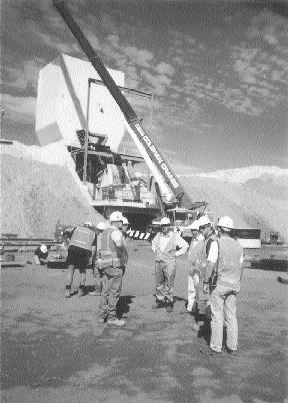Vancouver — The second quarter of 2003 was a stellar one for
LionOre earned US$11.1 million (or 7 per share) in the three months ended June 30, compared with a loss of US$600,000 (1 per share) in the corresponding period of 2002. Revenue between the two quarters jumped to US$71.2 million from US$10.4 million, while cash flow from operations rocketed to US$22.4 million from US$2.2 million.
“Our strong financial results are the product of exceeding our production and other operational goals,” says President Colin Steyn. “The higher-than-anticipated nickel prices had a positive effect on our results but only partially offset the adverse effects of the strengthening currencies in the countries where we operate.”
LionOre’s higher profits are largely attributable to its 85%-held Tati Nickel operation, which includes the Phoenix open-pit mine, 80 km east of Francistown in northeastern Botswana. Tati’s earnings before non-controlling interest amounted to US$7 million, compared with a year-earlier loss of US$800,000.
Tati Nickel delivered 3,252 tonnes of payable nickel during the recent period at a cash cost of US$2.24 per lb. Stockpiled nickel concentrate at the end of the recent quarter was 14,184 tonnes, down from 19,436 tonnes at the end of the first quarter, resulting in an after-tax profit of US$1.6 million.
The company’s Australian operations contributed US$6.7 million to the bottom line, compared with US$700,000 a year earlier.
In the Lake Johnston greenstone belt of Western Australia, the Emily Ann underground mine contributed 2,112 tonnes of nickel in the first quarter at a cash cost of US$1.80 per lb.
The nearby Maggie Hays nickel deposit, currently being developed, is expected to ramp up LionOre’s Australian nickel production to 10,000-12,000 tonnes per year by the end of 2004. The main massive sulphide zone contains an indicated resource of 633,000 tonnes grading 3.55% nickel. LionOre plans to mine the lower massive sulphide zone (probable reserve: 475,000 tonnes grading 3.55% nickel), while evaluating a small, high-grade section at the upper part of the zone by means of decline drilling. Incremental production from the high-grade section should be achieved in the second half of 2003, with production from the lower zone coming in the third quarter of 2004.
Based on a nickel price of US$3.25 per lb., average cash operating costs are pegged at US$170 per lb., which should generate about US$15 million is cash flow. Underground development costs of US$13 million will be funded using existing cash. The nickel concentrates will be sold to
In anticipation of the go-ahead, underground development at the Emily Ann mine has been ramped up, with annual production rising to 350,000 from 250,000 tonnes.
The high-grade section of the Maggie Hays deposit was discovered in 1993, and despite hosting an overall resource of 11 million tonnes grading 1.5% nickel, advancement of the project has been delayed by a complex ownership structure.
In May 2002, LionOre Mining secured a 9-month exclusive option agreement with the
Overall, the deposit is 1.4 km long and has a maximum downdip extension of 500 metres. Mineralization comprises mainly pyrrhotite and pentlandite, with lesser amounts of pyrite and chalcopyrite. The Main zone hosts disseminated mineralization up to 40 metres thick, stratigraphically underlain by a massive sulphide zone up to 7 metres wide. The disseminated mineralization contains 15-20% sulphides, while the basal massive sulphide contains around 80% sulphides.
Thunderbox
Meanwhile, in the Northeastern gold fields of Western Australia, LionOre’s 60%-owned Thunderbox gold mine cranked out 65,845 oz. gold at a cash cost of US$111 per oz. in the second quarter, compared with 62,878 oz. at US$106 per oz. in the January-to-March period (the mine’s first full quarter of production).
Exploration around the Thunderbox operation led to the discovery of a zone of primary gold mineralization. The so-called Zone D is immediately north of the existing pit. Reconnaissance holes returned up to 2.84 grams gold over 98.7 metres, and drilling continues to outline the extent of mineralization.
On June 3, LionOre and Aussie-listed Dalrymple Resources, which holds the remaining 40% stake in Thunderbox, entered into an agreement to merge. Under the deal, Dalrymple shareholders will receive one LionOre share for every 2.92 Dalrymple shares. The merger is expected to be completed in the fourth quarter.
At June 30, LionOre had working capital of US$24.8 million, up from US$5.9 million at the end of 2002, and debt of US$55.1 million, down from US$86.7 million.
“We remain well-funded to support our growth plan,” says Steyn. “With increasingly robust operations and a solid balance sheet, we are strongly positioned to grow through exploration and development of our existing properties.”


Be the first to comment on "LionOre posts record profit (August 25, 2003)"